A Report on Layoffs and Plant Issues in Singapore: Roles & Issues
VerifiedAdded on 2020/05/16
|11
|2325
|197
Report
AI Summary
This report analyzes the issues of layoffs and plant closures in Singapore, focusing on the roles of employers, employees, and the government in managing such situations. It examines specific cases, such as Coca-Cola Singapore Beverages and Goldman Sachs, to illustrate how companies handle retrenchment processes. The report highlights the importance of following government norms, informing the Ministry of Manpower, and providing appropriate notice periods and compensation. It also discusses the roles of labor unions in mediating between businesses and employees, ensuring fair practices and providing training opportunities. The government's involvement in ensuring the protection of employee rights through retrenchment policies, tripartite guidelines, and career counseling is also emphasized. The report concludes that government intervention and labor union support are crucial for safeguarding employee rights and promoting a stable employment environment in Singapore.
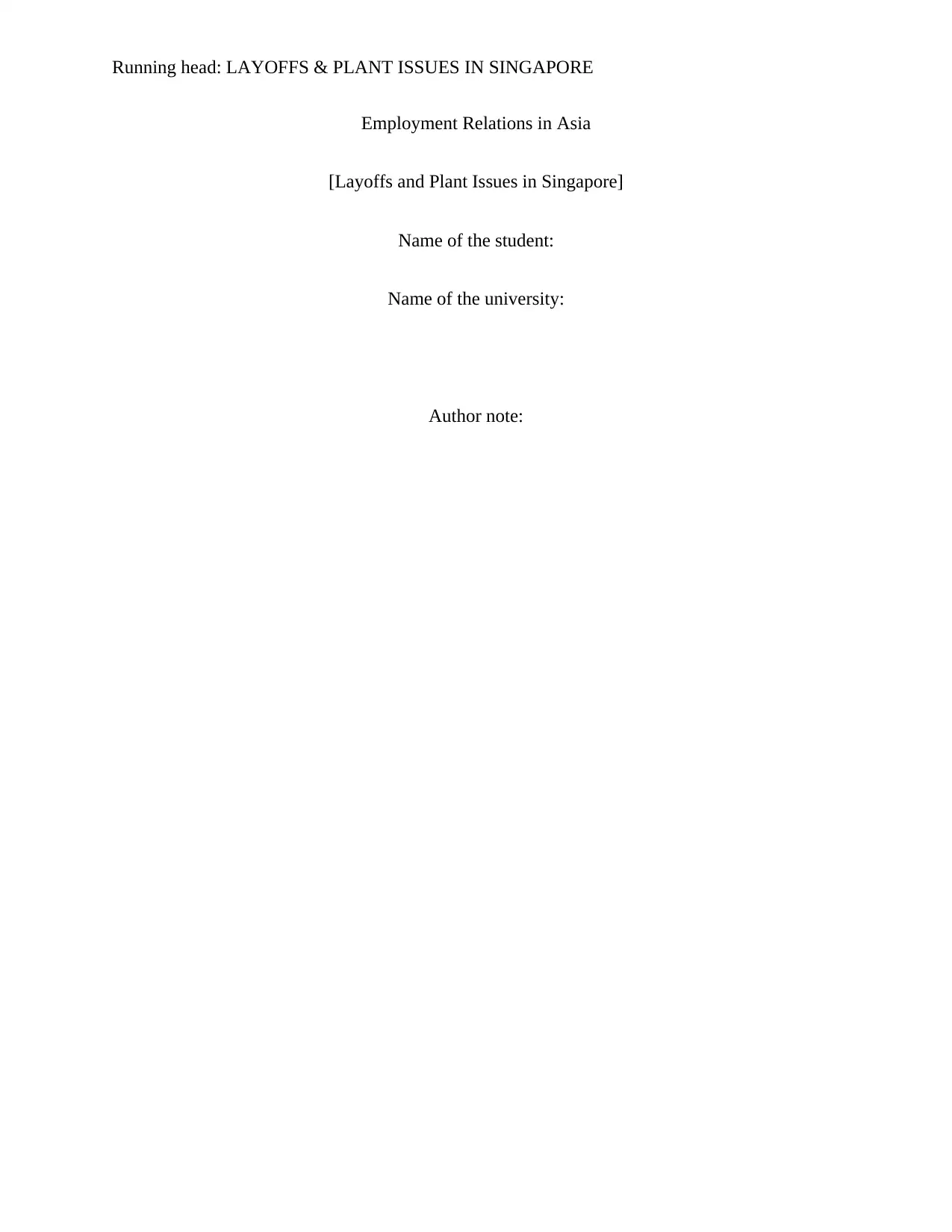
Running head: LAYOFFS & PLANT ISSUES IN SINGAPORE
Employment Relations in Asia
[Layoffs and Plant Issues in Singapore]
Name of the student:
Name of the university:
Author note:
Employment Relations in Asia
[Layoffs and Plant Issues in Singapore]
Name of the student:
Name of the university:
Author note:
Paraphrase This Document
Need a fresh take? Get an instant paraphrase of this document with our AI Paraphraser
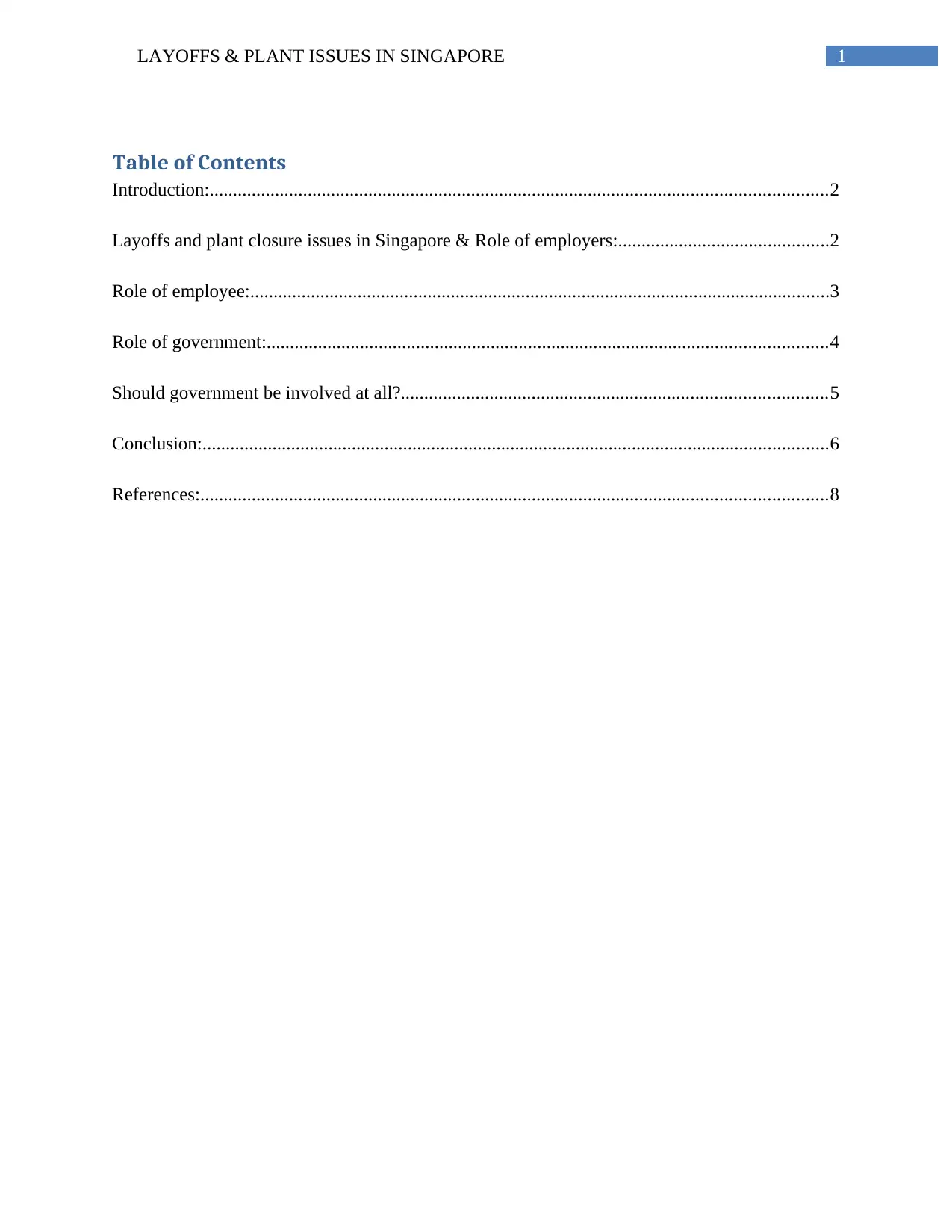
1LAYOFFS & PLANT ISSUES IN SINGAPORE
Table of Contents
Introduction:....................................................................................................................................2
Layoffs and plant closure issues in Singapore & Role of employers:.............................................2
Role of employee:............................................................................................................................3
Role of government:........................................................................................................................4
Should government be involved at all?...........................................................................................5
Conclusion:......................................................................................................................................6
References:......................................................................................................................................8
Table of Contents
Introduction:....................................................................................................................................2
Layoffs and plant closure issues in Singapore & Role of employers:.............................................2
Role of employee:............................................................................................................................3
Role of government:........................................................................................................................4
Should government be involved at all?...........................................................................................5
Conclusion:......................................................................................................................................6
References:......................................................................................................................................8
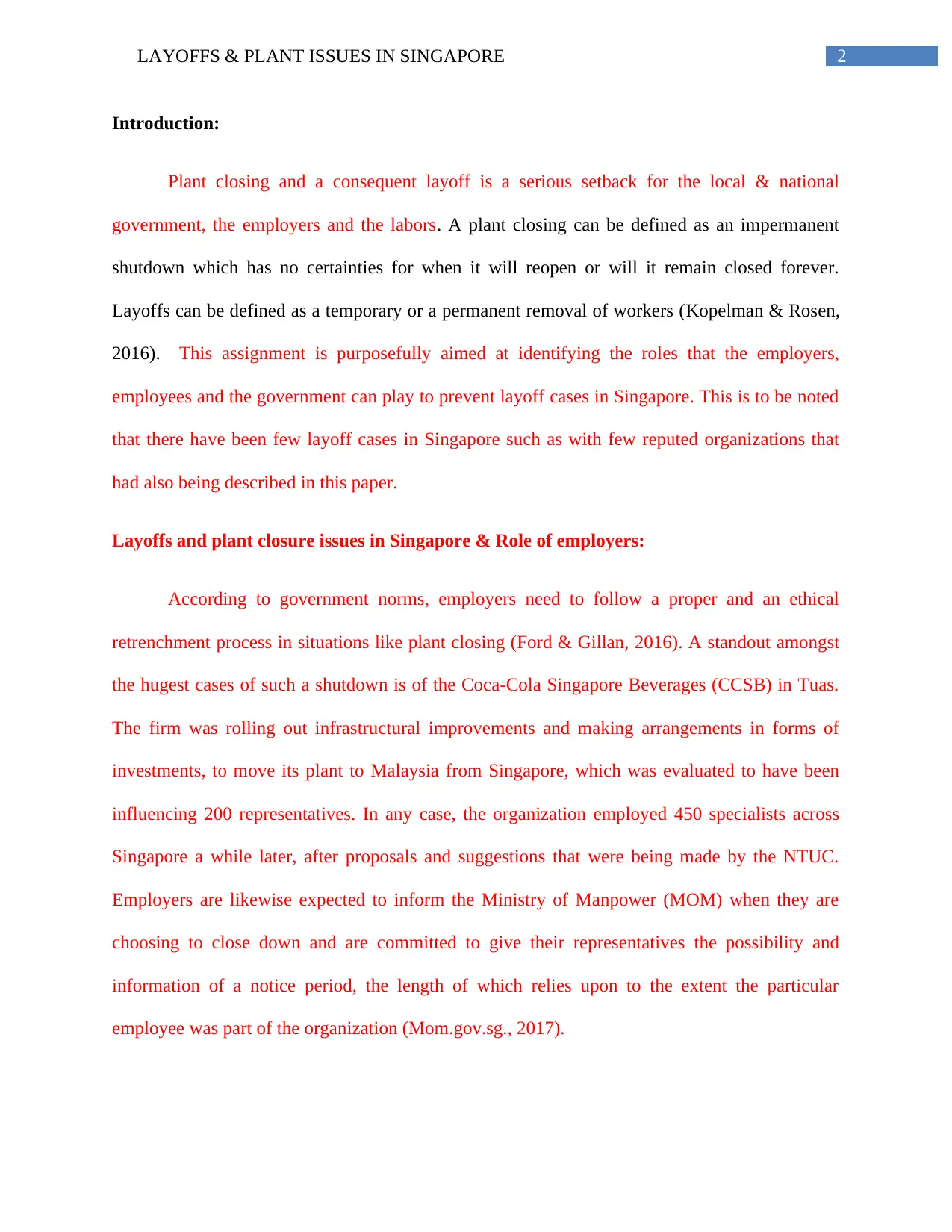
2LAYOFFS & PLANT ISSUES IN SINGAPORE
Introduction:
Plant closing and a consequent layoff is a serious setback for the local & national
government, the employers and the labors. A plant closing can be defined as an impermanent
shutdown which has no certainties for when it will reopen or will it remain closed forever.
Layoffs can be defined as a temporary or a permanent removal of workers (Kopelman & Rosen,
2016). This assignment is purposefully aimed at identifying the roles that the employers,
employees and the government can play to prevent layoff cases in Singapore. This is to be noted
that there have been few layoff cases in Singapore such as with few reputed organizations that
had also being described in this paper.
Layoffs and plant closure issues in Singapore & Role of employers:
According to government norms, employers need to follow a proper and an ethical
retrenchment process in situations like plant closing (Ford & Gillan, 2016). A standout amongst
the hugest cases of such a shutdown is of the Coca-Cola Singapore Beverages (CCSB) in Tuas.
The firm was rolling out infrastructural improvements and making arrangements in forms of
investments, to move its plant to Malaysia from Singapore, which was evaluated to have been
influencing 200 representatives. In any case, the organization employed 450 specialists across
Singapore a while later, after proposals and suggestions that were being made by the NTUC.
Employers are likewise expected to inform the Ministry of Manpower (MOM) when they are
choosing to close down and are committed to give their representatives the possibility and
information of a notice period, the length of which relies upon to the extent the particular
employee was part of the organization (Mom.gov.sg., 2017).
Introduction:
Plant closing and a consequent layoff is a serious setback for the local & national
government, the employers and the labors. A plant closing can be defined as an impermanent
shutdown which has no certainties for when it will reopen or will it remain closed forever.
Layoffs can be defined as a temporary or a permanent removal of workers (Kopelman & Rosen,
2016). This assignment is purposefully aimed at identifying the roles that the employers,
employees and the government can play to prevent layoff cases in Singapore. This is to be noted
that there have been few layoff cases in Singapore such as with few reputed organizations that
had also being described in this paper.
Layoffs and plant closure issues in Singapore & Role of employers:
According to government norms, employers need to follow a proper and an ethical
retrenchment process in situations like plant closing (Ford & Gillan, 2016). A standout amongst
the hugest cases of such a shutdown is of the Coca-Cola Singapore Beverages (CCSB) in Tuas.
The firm was rolling out infrastructural improvements and making arrangements in forms of
investments, to move its plant to Malaysia from Singapore, which was evaluated to have been
influencing 200 representatives. In any case, the organization employed 450 specialists across
Singapore a while later, after proposals and suggestions that were being made by the NTUC.
Employers are likewise expected to inform the Ministry of Manpower (MOM) when they are
choosing to close down and are committed to give their representatives the possibility and
information of a notice period, the length of which relies upon to the extent the particular
employee was part of the organization (Mom.gov.sg., 2017).
⊘ This is a preview!⊘
Do you want full access?
Subscribe today to unlock all pages.

Trusted by 1+ million students worldwide

3LAYOFFS & PLANT ISSUES IN SINGAPORE
The procedure has extraordinarily helped in guaranteeing the human rights of the works
as on account of employees of Resorts World Sentosa (Leong, 2016). The administration of
RWS worked pair with MOM and the Attractions, Resorts and Entertainment Union (AREU) to
ensure the representatives get their legitimate benefits. This case required the help of the
worker's parties as the people who did not take the conservation offer were sacked. The
organization had indeed needed to chop down expenses and preparing the workers. So that, it
could be ensured that workers acquire below SG $ 4500 were given repayment and training
(Leong, 2016).
The standards of retrenchment policies additionally helped workers on account of
Goldman Sach's downsizing of representatives in Singapore. The Goldman Sach's increasingly
cuts workers to keep up a productive income in terms with their rivals (Reuters, 2016). The
Management of Goldman Sach's ensure that representatives who are being conserved are advised
in advance and given appropriate repayment. The administration paid the representatives a
decent sum as a separating advantage as it was in moving activities. The representatives of the
Goldman Sachs were given better opportunities in aggressive firms to enhance their odds at
getting work.
Role of employee:
The labors and the labour unions have a noteworthy part to play in dealing with the
cutbacks in the association helping in the best possible management of the distinctive issues
emerging between the management and the employees amid the cutback procedure (Marginson,
2016). As per the laws in Singapore, the workers who have served over two years are qualified
The procedure has extraordinarily helped in guaranteeing the human rights of the works
as on account of employees of Resorts World Sentosa (Leong, 2016). The administration of
RWS worked pair with MOM and the Attractions, Resorts and Entertainment Union (AREU) to
ensure the representatives get their legitimate benefits. This case required the help of the
worker's parties as the people who did not take the conservation offer were sacked. The
organization had indeed needed to chop down expenses and preparing the workers. So that, it
could be ensured that workers acquire below SG $ 4500 were given repayment and training
(Leong, 2016).
The standards of retrenchment policies additionally helped workers on account of
Goldman Sach's downsizing of representatives in Singapore. The Goldman Sach's increasingly
cuts workers to keep up a productive income in terms with their rivals (Reuters, 2016). The
Management of Goldman Sach's ensure that representatives who are being conserved are advised
in advance and given appropriate repayment. The administration paid the representatives a
decent sum as a separating advantage as it was in moving activities. The representatives of the
Goldman Sachs were given better opportunities in aggressive firms to enhance their odds at
getting work.
Role of employee:
The labors and the labour unions have a noteworthy part to play in dealing with the
cutbacks in the association helping in the best possible management of the distinctive issues
emerging between the management and the employees amid the cutback procedure (Marginson,
2016). As per the laws in Singapore, the workers who have served over two years are qualified
Paraphrase This Document
Need a fresh take? Get an instant paraphrase of this document with our AI Paraphraser
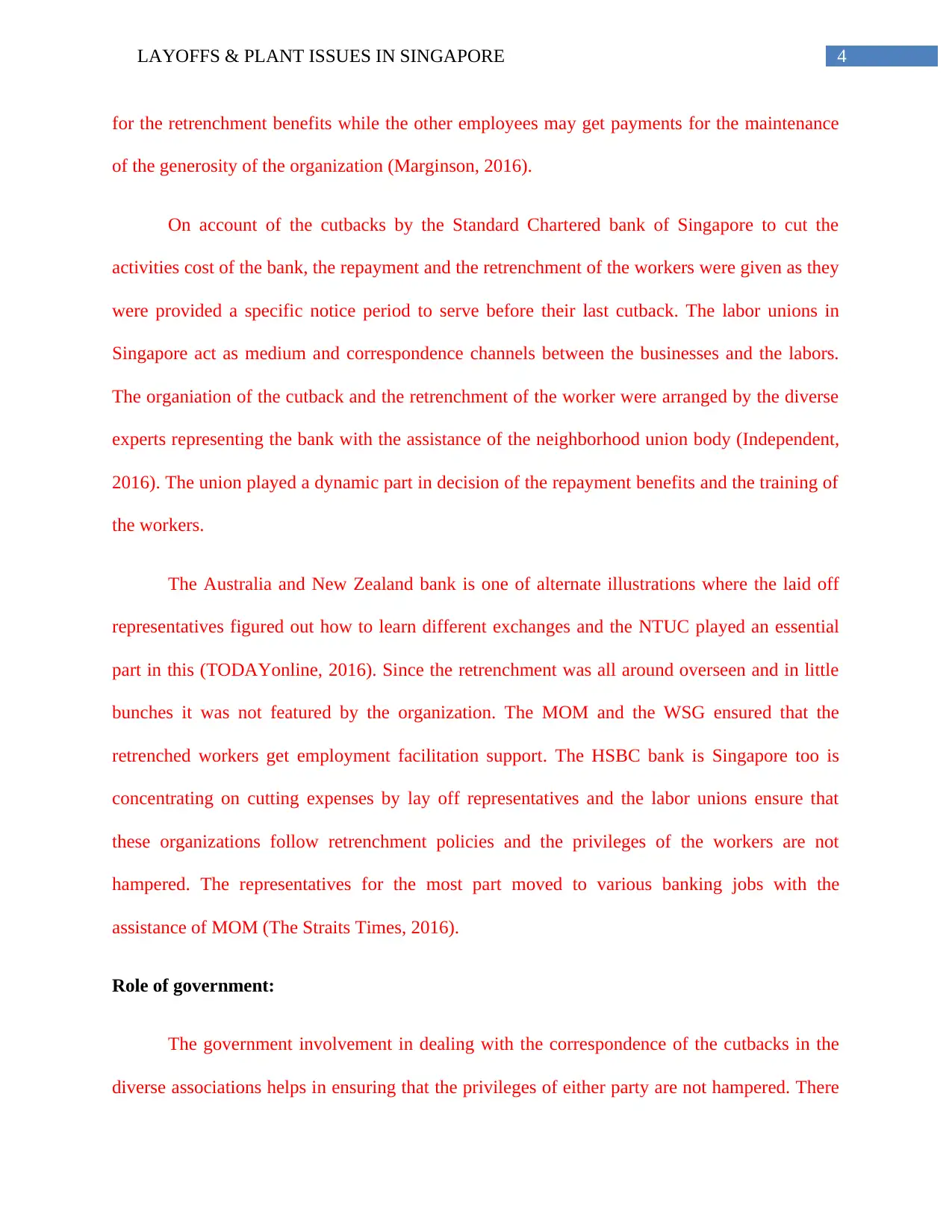
4LAYOFFS & PLANT ISSUES IN SINGAPORE
for the retrenchment benefits while the other employees may get payments for the maintenance
of the generosity of the organization (Marginson, 2016).
On account of the cutbacks by the Standard Chartered bank of Singapore to cut the
activities cost of the bank, the repayment and the retrenchment of the workers were given as they
were provided a specific notice period to serve before their last cutback. The labor unions in
Singapore act as medium and correspondence channels between the businesses and the labors.
The organiation of the cutback and the retrenchment of the worker were arranged by the diverse
experts representing the bank with the assistance of the neighborhood union body (Independent,
2016). The union played a dynamic part in decision of the repayment benefits and the training of
the workers.
The Australia and New Zealand bank is one of alternate illustrations where the laid off
representatives figured out how to learn different exchanges and the NTUC played an essential
part in this (TODAYonline, 2016). Since the retrenchment was all around overseen and in little
bunches it was not featured by the organization. The MOM and the WSG ensured that the
retrenched workers get employment facilitation support. The HSBC bank is Singapore too is
concentrating on cutting expenses by lay off representatives and the labor unions ensure that
these organizations follow retrenchment policies and the privileges of the workers are not
hampered. The representatives for the most part moved to various banking jobs with the
assistance of MOM (The Straits Times, 2016).
Role of government:
The government involvement in dealing with the correspondence of the cutbacks in the
diverse associations helps in ensuring that the privileges of either party are not hampered. There
for the retrenchment benefits while the other employees may get payments for the maintenance
of the generosity of the organization (Marginson, 2016).
On account of the cutbacks by the Standard Chartered bank of Singapore to cut the
activities cost of the bank, the repayment and the retrenchment of the workers were given as they
were provided a specific notice period to serve before their last cutback. The labor unions in
Singapore act as medium and correspondence channels between the businesses and the labors.
The organiation of the cutback and the retrenchment of the worker were arranged by the diverse
experts representing the bank with the assistance of the neighborhood union body (Independent,
2016). The union played a dynamic part in decision of the repayment benefits and the training of
the workers.
The Australia and New Zealand bank is one of alternate illustrations where the laid off
representatives figured out how to learn different exchanges and the NTUC played an essential
part in this (TODAYonline, 2016). Since the retrenchment was all around overseen and in little
bunches it was not featured by the organization. The MOM and the WSG ensured that the
retrenched workers get employment facilitation support. The HSBC bank is Singapore too is
concentrating on cutting expenses by lay off representatives and the labor unions ensure that
these organizations follow retrenchment policies and the privileges of the workers are not
hampered. The representatives for the most part moved to various banking jobs with the
assistance of MOM (The Straits Times, 2016).
Role of government:
The government involvement in dealing with the correspondence of the cutbacks in the
diverse associations helps in ensuring that the privileges of either party are not hampered. There
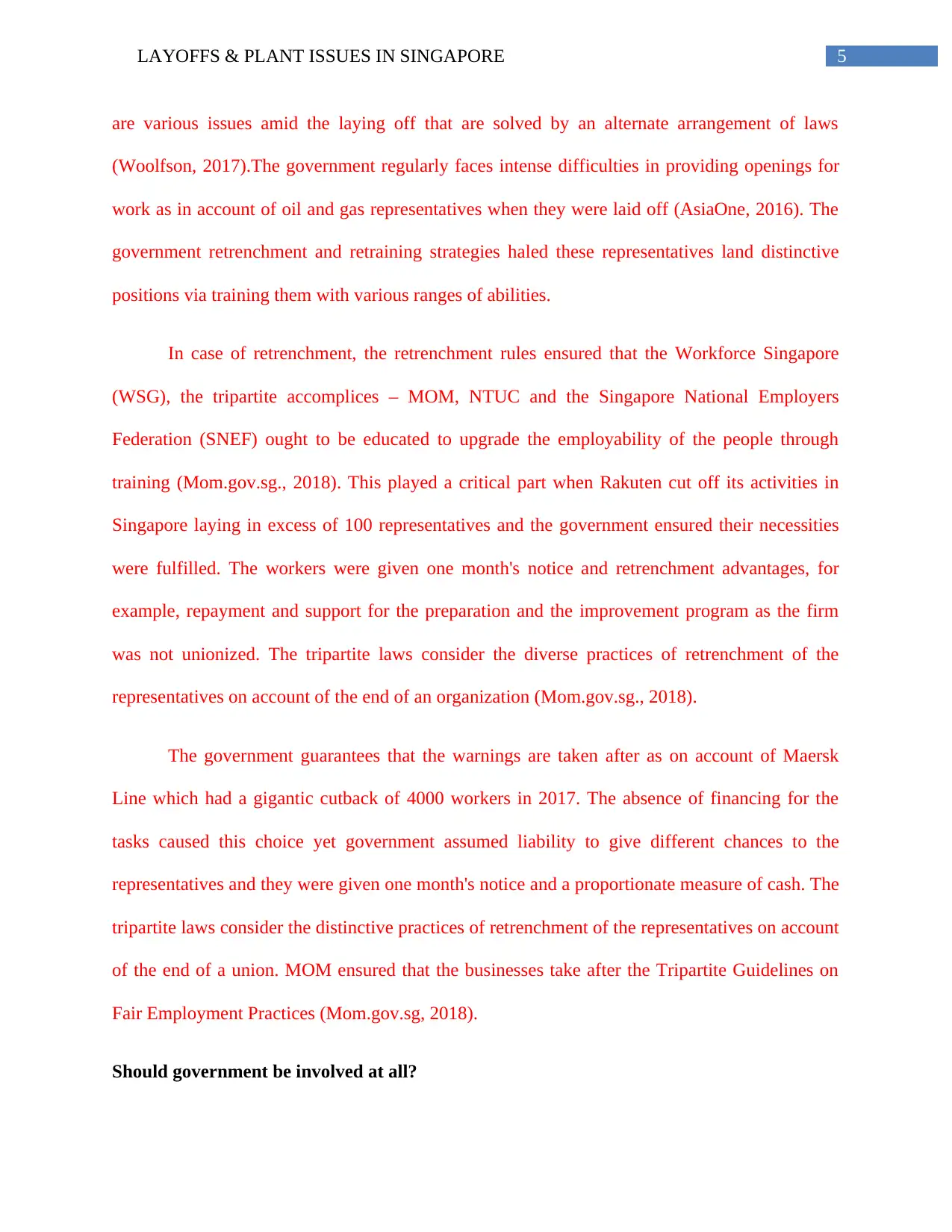
5LAYOFFS & PLANT ISSUES IN SINGAPORE
are various issues amid the laying off that are solved by an alternate arrangement of laws
(Woolfson, 2017).The government regularly faces intense difficulties in providing openings for
work as in account of oil and gas representatives when they were laid off (AsiaOne, 2016). The
government retrenchment and retraining strategies haled these representatives land distinctive
positions via training them with various ranges of abilities.
In case of retrenchment, the retrenchment rules ensured that the Workforce Singapore
(WSG), the tripartite accomplices – MOM, NTUC and the Singapore National Employers
Federation (SNEF) ought to be educated to upgrade the employability of the people through
training (Mom.gov.sg., 2018). This played a critical part when Rakuten cut off its activities in
Singapore laying in excess of 100 representatives and the government ensured their necessities
were fulfilled. The workers were given one month's notice and retrenchment advantages, for
example, repayment and support for the preparation and the improvement program as the firm
was not unionized. The tripartite laws consider the diverse practices of retrenchment of the
representatives on account of the end of an organization (Mom.gov.sg., 2018).
The government guarantees that the warnings are taken after as on account of Maersk
Line which had a gigantic cutback of 4000 workers in 2017. The absence of financing for the
tasks caused this choice yet government assumed liability to give different chances to the
representatives and they were given one month's notice and a proportionate measure of cash. The
tripartite laws consider the distinctive practices of retrenchment of the representatives on account
of the end of a union. MOM ensured that the businesses take after the Tripartite Guidelines on
Fair Employment Practices (Mom.gov.sg, 2018).
Should government be involved at all?
are various issues amid the laying off that are solved by an alternate arrangement of laws
(Woolfson, 2017).The government regularly faces intense difficulties in providing openings for
work as in account of oil and gas representatives when they were laid off (AsiaOne, 2016). The
government retrenchment and retraining strategies haled these representatives land distinctive
positions via training them with various ranges of abilities.
In case of retrenchment, the retrenchment rules ensured that the Workforce Singapore
(WSG), the tripartite accomplices – MOM, NTUC and the Singapore National Employers
Federation (SNEF) ought to be educated to upgrade the employability of the people through
training (Mom.gov.sg., 2018). This played a critical part when Rakuten cut off its activities in
Singapore laying in excess of 100 representatives and the government ensured their necessities
were fulfilled. The workers were given one month's notice and retrenchment advantages, for
example, repayment and support for the preparation and the improvement program as the firm
was not unionized. The tripartite laws consider the diverse practices of retrenchment of the
representatives on account of the end of an organization (Mom.gov.sg., 2018).
The government guarantees that the warnings are taken after as on account of Maersk
Line which had a gigantic cutback of 4000 workers in 2017. The absence of financing for the
tasks caused this choice yet government assumed liability to give different chances to the
representatives and they were given one month's notice and a proportionate measure of cash. The
tripartite laws consider the distinctive practices of retrenchment of the representatives on account
of the end of a union. MOM ensured that the businesses take after the Tripartite Guidelines on
Fair Employment Practices (Mom.gov.sg, 2018).
Should government be involved at all?
⊘ This is a preview!⊘
Do you want full access?
Subscribe today to unlock all pages.

Trusted by 1+ million students worldwide
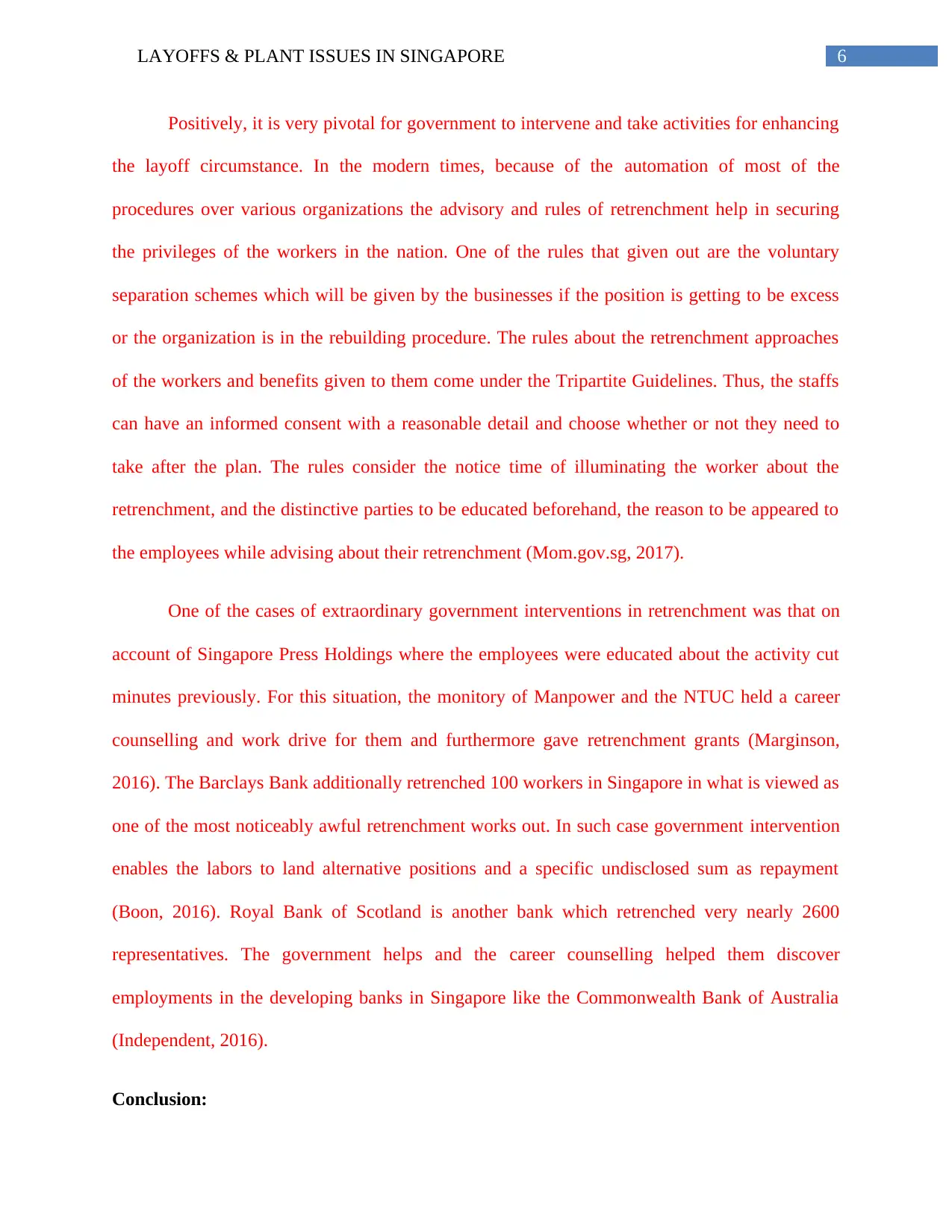
6LAYOFFS & PLANT ISSUES IN SINGAPORE
Positively, it is very pivotal for government to intervene and take activities for enhancing
the layoff circumstance. In the modern times, because of the automation of most of the
procedures over various organizations the advisory and rules of retrenchment help in securing
the privileges of the workers in the nation. One of the rules that given out are the voluntary
separation schemes which will be given by the businesses if the position is getting to be excess
or the organization is in the rebuilding procedure. The rules about the retrenchment approaches
of the workers and benefits given to them come under the Tripartite Guidelines. Thus, the staffs
can have an informed consent with a reasonable detail and choose whether or not they need to
take after the plan. The rules consider the notice time of illuminating the worker about the
retrenchment, and the distinctive parties to be educated beforehand, the reason to be appeared to
the employees while advising about their retrenchment (Mom.gov.sg, 2017).
One of the cases of extraordinary government interventions in retrenchment was that on
account of Singapore Press Holdings where the employees were educated about the activity cut
minutes previously. For this situation, the monitory of Manpower and the NTUC held a career
counselling and work drive for them and furthermore gave retrenchment grants (Marginson,
2016). The Barclays Bank additionally retrenched 100 workers in Singapore in what is viewed as
one of the most noticeably awful retrenchment works out. In such case government intervention
enables the labors to land alternative positions and a specific undisclosed sum as repayment
(Boon, 2016). Royal Bank of Scotland is another bank which retrenched very nearly 2600
representatives. The government helps and the career counselling helped them discover
employments in the developing banks in Singapore like the Commonwealth Bank of Australia
(Independent, 2016).
Conclusion:
Positively, it is very pivotal for government to intervene and take activities for enhancing
the layoff circumstance. In the modern times, because of the automation of most of the
procedures over various organizations the advisory and rules of retrenchment help in securing
the privileges of the workers in the nation. One of the rules that given out are the voluntary
separation schemes which will be given by the businesses if the position is getting to be excess
or the organization is in the rebuilding procedure. The rules about the retrenchment approaches
of the workers and benefits given to them come under the Tripartite Guidelines. Thus, the staffs
can have an informed consent with a reasonable detail and choose whether or not they need to
take after the plan. The rules consider the notice time of illuminating the worker about the
retrenchment, and the distinctive parties to be educated beforehand, the reason to be appeared to
the employees while advising about their retrenchment (Mom.gov.sg, 2017).
One of the cases of extraordinary government interventions in retrenchment was that on
account of Singapore Press Holdings where the employees were educated about the activity cut
minutes previously. For this situation, the monitory of Manpower and the NTUC held a career
counselling and work drive for them and furthermore gave retrenchment grants (Marginson,
2016). The Barclays Bank additionally retrenched 100 workers in Singapore in what is viewed as
one of the most noticeably awful retrenchment works out. In such case government intervention
enables the labors to land alternative positions and a specific undisclosed sum as repayment
(Boon, 2016). Royal Bank of Scotland is another bank which retrenched very nearly 2600
representatives. The government helps and the career counselling helped them discover
employments in the developing banks in Singapore like the Commonwealth Bank of Australia
(Independent, 2016).
Conclusion:
Paraphrase This Document
Need a fresh take? Get an instant paraphrase of this document with our AI Paraphraser
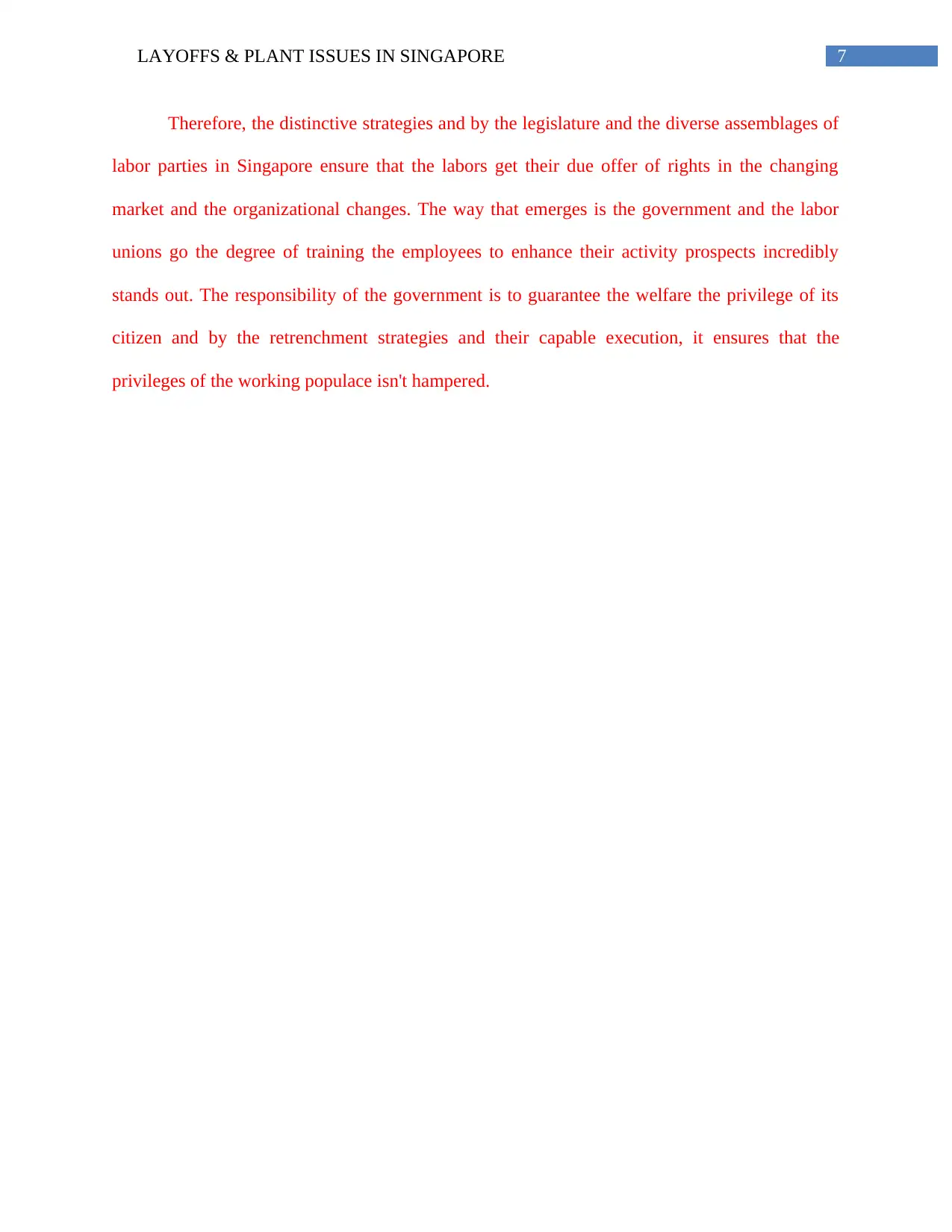
7LAYOFFS & PLANT ISSUES IN SINGAPORE
Therefore, the distinctive strategies and by the legislature and the diverse assemblages of
labor parties in Singapore ensure that the labors get their due offer of rights in the changing
market and the organizational changes. The way that emerges is the government and the labor
unions go the degree of training the employees to enhance their activity prospects incredibly
stands out. The responsibility of the government is to guarantee the welfare the privilege of its
citizen and by the retrenchment strategies and their capable execution, it ensures that the
privileges of the working populace isn't hampered.
Therefore, the distinctive strategies and by the legislature and the diverse assemblages of
labor parties in Singapore ensure that the labors get their due offer of rights in the changing
market and the organizational changes. The way that emerges is the government and the labor
unions go the degree of training the employees to enhance their activity prospects incredibly
stands out. The responsibility of the government is to guarantee the welfare the privilege of its
citizen and by the retrenchment strategies and their capable execution, it ensures that the
privileges of the working populace isn't hampered.

8LAYOFFS & PLANT ISSUES IN SINGAPORE
References:
Abdullah, A. B. M. (2017). Managing the Psychological Contract: Employee Relations in South
Asia. Springer.
AsiaOne. (2016). Axe to fall on hundreds more in Singapore oil & gas sector. [online] Available
at: http://www.asiaone.com/business/axe-fall-hundreds-more-singapore-oil-gas-sector
[Accessed 18 Feb. 2018].
Boxall, P. (2014). The future of employment relations from the perspective of human resource
management. Journal of Industrial Relations, 56(4), 578-593.
Donaghey, J., Reinecke, J., Niforou, C., & Lawson, B. (2014). From employment relations to
consumption relations: Balancing labor governance in global supply chains. Human
Resource Management, 53(2), 229-252.
Ford, M., & Gillan, M. (2016). Employment relations and the state in Southeast Asia. Journal of
Industrial Relations, 58(2), 167-182.
Friedman, E., & Kuruvilla, S. (2015). Experimentation and decentralization in China’s labor
relations. Human Relations, 68(2), 181-195.
Harris, T. R. (2016). A phenomenological investigation of small-business closure in California:
An examination of the leadership process. Pepperdine University.
Independent, T. (2016). Few jobs available for retrenched senior banking staff. [online] The
Independent. Available at: http://www.theindependent.sg/few-jobs-available-for-
retrenched-senior-banking-staff/ [Accessed 19 Feb. 2018].
References:
Abdullah, A. B. M. (2017). Managing the Psychological Contract: Employee Relations in South
Asia. Springer.
AsiaOne. (2016). Axe to fall on hundreds more in Singapore oil & gas sector. [online] Available
at: http://www.asiaone.com/business/axe-fall-hundreds-more-singapore-oil-gas-sector
[Accessed 18 Feb. 2018].
Boxall, P. (2014). The future of employment relations from the perspective of human resource
management. Journal of Industrial Relations, 56(4), 578-593.
Donaghey, J., Reinecke, J., Niforou, C., & Lawson, B. (2014). From employment relations to
consumption relations: Balancing labor governance in global supply chains. Human
Resource Management, 53(2), 229-252.
Ford, M., & Gillan, M. (2016). Employment relations and the state in Southeast Asia. Journal of
Industrial Relations, 58(2), 167-182.
Friedman, E., & Kuruvilla, S. (2015). Experimentation and decentralization in China’s labor
relations. Human Relations, 68(2), 181-195.
Harris, T. R. (2016). A phenomenological investigation of small-business closure in California:
An examination of the leadership process. Pepperdine University.
Independent, T. (2016). Few jobs available for retrenched senior banking staff. [online] The
Independent. Available at: http://www.theindependent.sg/few-jobs-available-for-
retrenched-senior-banking-staff/ [Accessed 19 Feb. 2018].
⊘ This is a preview!⊘
Do you want full access?
Subscribe today to unlock all pages.

Trusted by 1+ million students worldwide
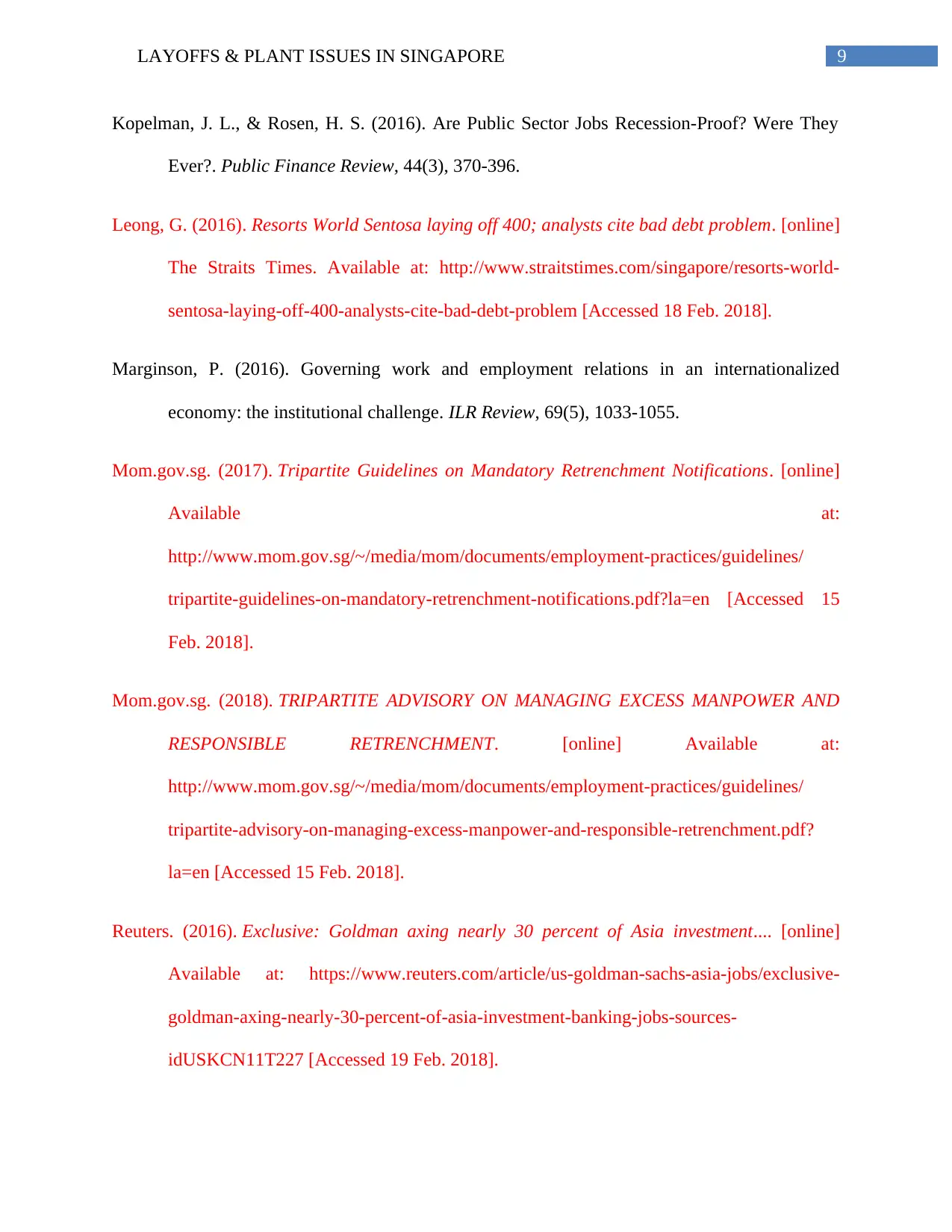
9LAYOFFS & PLANT ISSUES IN SINGAPORE
Kopelman, J. L., & Rosen, H. S. (2016). Are Public Sector Jobs Recession-Proof? Were They
Ever?. Public Finance Review, 44(3), 370-396.
Leong, G. (2016). Resorts World Sentosa laying off 400; analysts cite bad debt problem. [online]
The Straits Times. Available at: http://www.straitstimes.com/singapore/resorts-world-
sentosa-laying-off-400-analysts-cite-bad-debt-problem [Accessed 18 Feb. 2018].
Marginson, P. (2016). Governing work and employment relations in an internationalized
economy: the institutional challenge. ILR Review, 69(5), 1033-1055.
Mom.gov.sg. (2017). Tripartite Guidelines on Mandatory Retrenchment Notifications. [online]
Available at:
http://www.mom.gov.sg/~/media/mom/documents/employment-practices/guidelines/
tripartite-guidelines-on-mandatory-retrenchment-notifications.pdf?la=en [Accessed 15
Feb. 2018].
Mom.gov.sg. (2018). TRIPARTITE ADVISORY ON MANAGING EXCESS MANPOWER AND
RESPONSIBLE RETRENCHMENT. [online] Available at:
http://www.mom.gov.sg/~/media/mom/documents/employment-practices/guidelines/
tripartite-advisory-on-managing-excess-manpower-and-responsible-retrenchment.pdf?
la=en [Accessed 15 Feb. 2018].
Reuters. (2016). Exclusive: Goldman axing nearly 30 percent of Asia investment.... [online]
Available at: https://www.reuters.com/article/us-goldman-sachs-asia-jobs/exclusive-
goldman-axing-nearly-30-percent-of-asia-investment-banking-jobs-sources-
idUSKCN11T227 [Accessed 19 Feb. 2018].
Kopelman, J. L., & Rosen, H. S. (2016). Are Public Sector Jobs Recession-Proof? Were They
Ever?. Public Finance Review, 44(3), 370-396.
Leong, G. (2016). Resorts World Sentosa laying off 400; analysts cite bad debt problem. [online]
The Straits Times. Available at: http://www.straitstimes.com/singapore/resorts-world-
sentosa-laying-off-400-analysts-cite-bad-debt-problem [Accessed 18 Feb. 2018].
Marginson, P. (2016). Governing work and employment relations in an internationalized
economy: the institutional challenge. ILR Review, 69(5), 1033-1055.
Mom.gov.sg. (2017). Tripartite Guidelines on Mandatory Retrenchment Notifications. [online]
Available at:
http://www.mom.gov.sg/~/media/mom/documents/employment-practices/guidelines/
tripartite-guidelines-on-mandatory-retrenchment-notifications.pdf?la=en [Accessed 15
Feb. 2018].
Mom.gov.sg. (2018). TRIPARTITE ADVISORY ON MANAGING EXCESS MANPOWER AND
RESPONSIBLE RETRENCHMENT. [online] Available at:
http://www.mom.gov.sg/~/media/mom/documents/employment-practices/guidelines/
tripartite-advisory-on-managing-excess-manpower-and-responsible-retrenchment.pdf?
la=en [Accessed 15 Feb. 2018].
Reuters. (2016). Exclusive: Goldman axing nearly 30 percent of Asia investment.... [online]
Available at: https://www.reuters.com/article/us-goldman-sachs-asia-jobs/exclusive-
goldman-axing-nearly-30-percent-of-asia-investment-banking-jobs-sources-
idUSKCN11T227 [Accessed 19 Feb. 2018].
Paraphrase This Document
Need a fresh take? Get an instant paraphrase of this document with our AI Paraphraser

10LAYOFFS & PLANT ISSUES IN SINGAPORE
The Straits Times. (2016). HSBC said to cut senior investment-banking jobs to lower costs.
[online] Available at: http://www.straitstimes.com/business/banking/hsbc-said-to-cut-
senior-investment-banking-jobs-to-lower-costs [Accessed 18 Feb. 2018].
TODAYonline. (2016). S’pore job cuts at ANZ leave employees uncertain about future. [online]
Available at: http://www.todayonline.com/business/spore-job-cuts-anz-leave-employees-
uncertain-about-future [Accessed 18 Feb. 2018].
Woolfson, C. (2017). The ‘Singapore scenario’: the uncertain prospects for labour standards in
post‐Brexit Britain. Industrial Relations Journal, 48(5-6), 384-402.
The Straits Times. (2016). HSBC said to cut senior investment-banking jobs to lower costs.
[online] Available at: http://www.straitstimes.com/business/banking/hsbc-said-to-cut-
senior-investment-banking-jobs-to-lower-costs [Accessed 18 Feb. 2018].
TODAYonline. (2016). S’pore job cuts at ANZ leave employees uncertain about future. [online]
Available at: http://www.todayonline.com/business/spore-job-cuts-anz-leave-employees-
uncertain-about-future [Accessed 18 Feb. 2018].
Woolfson, C. (2017). The ‘Singapore scenario’: the uncertain prospects for labour standards in
post‐Brexit Britain. Industrial Relations Journal, 48(5-6), 384-402.
1 out of 11
Your All-in-One AI-Powered Toolkit for Academic Success.
+13062052269
info@desklib.com
Available 24*7 on WhatsApp / Email
![[object Object]](/_next/static/media/star-bottom.7253800d.svg)
Unlock your academic potential
Copyright © 2020–2025 A2Z Services. All Rights Reserved. Developed and managed by ZUCOL.


